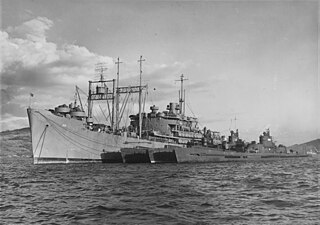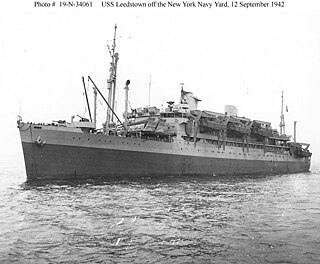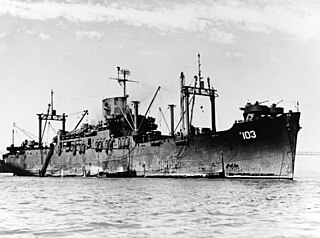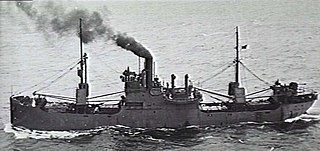USS Florence Nightingale (AP-70) was a Maritime Commission type C3-M cargo ship built as Mormacsun for Moore-McCormack Lines. Mormacsun operated for Moore-McCormack from May 1941 until December 1941 when she came under the War Shipping Administration (WSA) for the duration of World War II. The ship operated with Moore-McCormack as the WSA agent, playing an important role in early supply of the Southwest Pacific, until transfer to the United States Navy September 1942 and commissioning as Florence Nightingale whereupon she became an Elizabeth C. Stanton-class transport ship. She was named for Florence Nightingale (1820–1910), the nursing pioneer, and is one of the few United States Navy ships named after a woman. The ship was returned to WSA in 1946 and then to Moore-McCormack operating as Mormacsun until sold to operate as Japan Transport and lastly as Texas.

Stradbroke Island, also known as Minjerribah, was a large sand island that formed much of the eastern side of Moreton Bay near Brisbane, Queensland until the late 19th century. Today the island is split into two islands: North Stradbroke Island and South Stradbroke Island, separated by the Jumpinpin Channel.

The War Shipping Administration (WSA) was a World War II emergency war agency of the US government, tasked to purchase and operate the civilian shipping tonnage the United States needed for fighting the war. Both shipbuilding under the Maritime Commission and ship allocation under the WSA to Army, Navy or civilian needs were closely coordinated though Vice Admiral Emory S. Land who continued as head of the Maritime Commission while also heading the WSA.
USS Leonis (AK-128) was a Crater-class cargo ship in service with the US Navy in World War II. It was the only ship of the Navy to have borne this name, Latin for "of a lion", presumably referring to the northern constellation Leo.
Amity is a rural town and locality in the City of Redland, Queensland, Australia. In the 2016 census, the locality of Amity had a population of 387 people.

MS Klipfontein was a Dutch ocean liner launched in March 1939 and delivered 29 July intended for South African service. Declaration of war in Europe, including Britain and South Africa declaring war on Germany, resulted in the ship being transferred to service between the Dutch East Indies and the west coast of North America. After the German invasion of the Netherlands in May 1939, with the Dutch government in exile in London, the ship supported the Allied war effort. After entry of the United States into the war the ship was operated by Dutch agents of the U.S. War Shipping Administration (WSA) from February 1942 to February 1946 as a troopship from the U.S. West Coast to Pacific war zones.

USS Euryale (AS-22) was built as the Hawaiian Merchant by the Federal Shipbuilding and Drydock Company in Kearny, New Jersey for the Matson Navigation Company. Hawaiian Merchant was launched 12 April 1941, minutes after sister ship Hawaiian Shipper, and was completed April 1941. Matson intended the ship to join Hawaiian Planter and Hawaiian Shipper in the U.S. Pacific Coast—Australia route. The ship was under United States Army Transportation Corps charter when the United States went to war and came under the control of the War Shipping Administration which allocated the ship to the Army's continued charter until the ship was purchased 15 April 1943 by the United States Navy and commissioned 2 December 1943 as USS Euryale (AS-22), serving as a submarine tender through the war. Euryale was decommissioned 7 October 1946, going into reserve until 9 August 1972 when she was delivered to the Maritime Administration with immediate sale to American Ship Dismantler, Inc. for disposal.

USS Mizar (AF-12) was the United Fruit Company fruit, mail and passenger liner Quirigua that served as a United States Navy Mizar-class stores ship in World War II.

USS Leedstown (AP-73), built as the Grace Line passenger and cargo ocean liner SS Santa Lucia, served as a United States Navy amphibious assault ship in World War II. The ship had first been turned over to the War Shipping Administration (WSA) and operated by Grace Line as the WSA agent from February to August 1942 in the Pacific. In August the ship, at New York, was turned over to the Navy under sub-bareboat charter from WSA. She was sunk 9 November 1942 off the Algerian coast by a German submarine after German bombers caused damage the day before.

USS President Polk (AP-103) was a President Jackson-class attack transport in the service of the United States Navy during World War II.

USS Majaba (AG-43/IX-102) was the Design 1049 cargo ship Meriden built in 1919 by the Albina Engine & Machine Works, Portland, Oregon. All the ships were requisitioned by the United States Shipping Board (USSB) for World War I service. The ship was bought by the E. K. Wood Lumber Co., of San Francisco, California in 1923 and renamed El Capitan. The ship was chartered by the U.S. Navy through the War Shipping Administration (WSA) in April 1942 and commissioned as Majaba.

SS Sea Marlin was a C3-S-A2 cargo ship operated for the War Shipping Administration (WSA) by Grace Lines during World War II. WSA allocated Sea Marlin to United States Army requirements. Sea Marlin was crewed by United States Merchant Marines, with a contingent of the US Naval Armed Guards for the guns and had a complement of the US Army Transportation Corps aboard for troop administration.

South Passage is channel between the South Pacific Ocean and Moreton Bay. The other entrances to the bay are the North Passage or North Entrance and Jumpinpin Channel in the south.

The U.S. Army acquired ten ships during World War II as Engineer Port Repair Ships, also sometimes known as Port Rehabilitation ships, for use by the U.S. Army Corps of Engineers to clear war damaged harbors. The need was anticipated by 1942 for the post invasion recovery of ports in Europe and the Transportation Corps was assigned the responsibility to acquire and modify the ships that would be military crewed under the Corps of Engineers.

President Taylor was a cargo-liner, ex President Polk, ex Granite State, requisitioned for war service in December 1941 and allocated by the War Shipping Administration (WSA) to the U.S. Army and operating as a troopship in the Pacific Ocean in World War II when grounded and eventually lost on 14 February 1942.

MS Sea Witch was a United States Maritime Commission type C2 cargo ship, the first of four pre-war hulls, built by Tampa Shipbuilding & Engineering Company, Tampa, Florida and delivered in July 1940. The ship was of the basic C2 design, rather than the more numerous C2-S, C2-S-A1, C2-S-B1 types and four C2-T hulls delivered December 1941 through March 1942. Sea Witch was one of the relatively few C2 types built with diesel engines.

Dunwich Convict Causeway is a heritage-listed causeway at Junner Street, Dunwich, North Stradbroke Island in the City of Redland, Queensland, Australia. It was built in 1827 by convict labour for the Moreton Bay penal settlement. It was added to the Queensland Heritage Register on 22 October 1999.

SS Lake Elsmere was an Emergency Fleet Corporation (EFC) Design 1074 cargo ship built for the United States Shipping Board (USSB) during the massive shipbuilding effort of World War I.
















